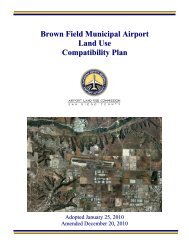Draft EA - San Diego International Airport
Draft EA - San Diego International Airport
Draft EA - San Diego International Airport
You also want an ePaper? Increase the reach of your titles
YUMPU automatically turns print PDFs into web optimized ePapers that Google loves.
SAN DIEGO INTERNATIONAL AIRPORT – PROPOSED RUNWAY 9 DISPLACED THRESHOLD<br />
In addition, rainfall runoff as a potential transport mechanism for pollutants, these same pollutants have the<br />
potential to be transported by “dry weather runoff/dry weather flows”. Any flow in the stormwater<br />
conveyance system during periods of dry weather is considered a dry weather flow. Dry weather flows can<br />
originate from over irrigation of landscaped areas, air conditioning condensation, high groundwater or<br />
groundwater sump pumps, and accidental, improper, or illegal discharges to the stormwater conveyance<br />
system. Common examples of the latter are accidental spills of jet fuel or lavatory waste, or improper vehicle<br />
or pavement washing activities, or illegally disposed used motor oil or antifreeze.<br />
In light of the potential for pollutants to be transported to <strong>San</strong> <strong>Diego</strong> Bay through the stormwater conveyance<br />
system, SDIA is subject to both the State Industrial General Stormwater Permit (National Pollutant Discharge<br />
Elimination System (NPDES) Permit No. CAS000001) and the <strong>San</strong> <strong>Diego</strong> Municipal Stormwater Permit (NPDES<br />
Permit No. CAS0108758). In response to these permit requirements, the SDCRAA has developed and<br />
implemented a stormwater management program to prevent or reduce the discharge of polluted runoff from<br />
SDIA during rain events and during instances of dry weather flow.<br />
Due to poor quality, groundwater underlying SDIA and the former NTC is not used for drinking, irrigation, or<br />
industrial supply purposes. No existing or potential beneficial uses for groundwater are designated in these<br />
areas. According to the <strong>San</strong> <strong>Diego</strong> Basin Plan, groundwater within this Hydrologic Area has been exempted<br />
by the <strong>San</strong> <strong>Diego</strong> Regional Water Quality Control Board (RWQCB) from the municipal use designation under<br />
the terms and conditions of State Board Resolution No. 88-63, “Sources of Drinking Water Policy.”<br />
Groundwater testing at the former NTC indicates that metals and minerals did not exceed total threshold<br />
concentration limits; however, concentrations of chromium, copper, lead, nickel, and zinc exceeded <strong>San</strong> <strong>Diego</strong><br />
RWQCB standards for protection of marine resources in <strong>San</strong> <strong>Diego</strong> Bay. Groundwater exceeding these<br />
standards, removed as part of construction site dewatering activities at SDIA, is subject to NPDES permitting<br />
and would require either discharge into the sanitary sewer system or treatment before discharge into the<br />
Bay. 30<br />
3.5.3 WETLANDS<br />
The U.S. Army Corps of Engineers’ (USACE) Wetland Delineation Manual defines wetland areas that have<br />
positive indicators for hydrophytic vegetation, wetland hydrology, and hydric soils as “areas that are<br />
inundated or saturated by surface or ground water at a frequency and duration sufficient to support, and that<br />
under normal circumstances do support, a prevalence of vegetation typically adapted for life in saturated soil<br />
conditions.” The USACE typically takes jurisdiction over wetlands only when they lie within or adjacent to<br />
navigable waters, or tributaries of such waters where those tributaries bear an ordinary high water mark. An<br />
ordinary high water mark is defined as “that line on the shore established by the fluctuations of water and<br />
indicated by physical characteristics such as a clear, natural line impressed on the bank, shelving, changes in<br />
soil character, destruction of terrestrial vegetation, presence of litter or debris, or other appropriate means<br />
that consider the characteristics of the surrounding areas.”<br />
30<br />
Redevelopment Agency of the City of <strong>San</strong> <strong>Diego</strong>, November 1999.<br />
<strong>Draft</strong> <strong>EA</strong><br />
Affected Environment<br />
[3-21]
















